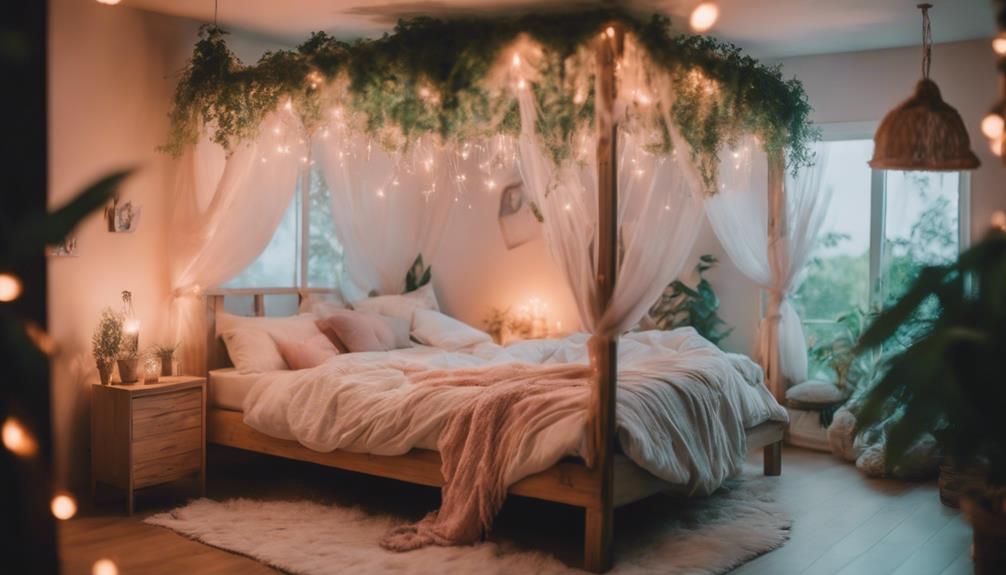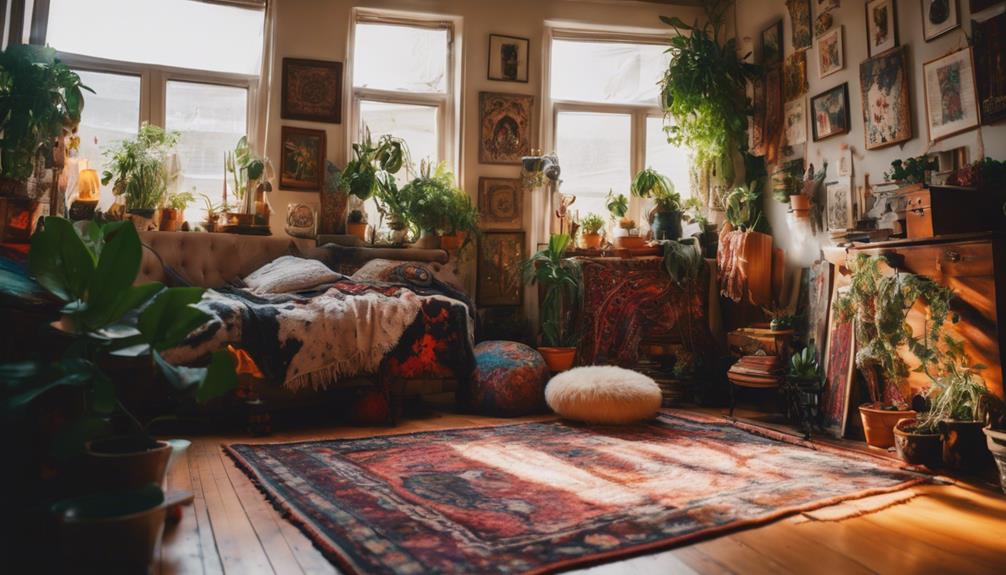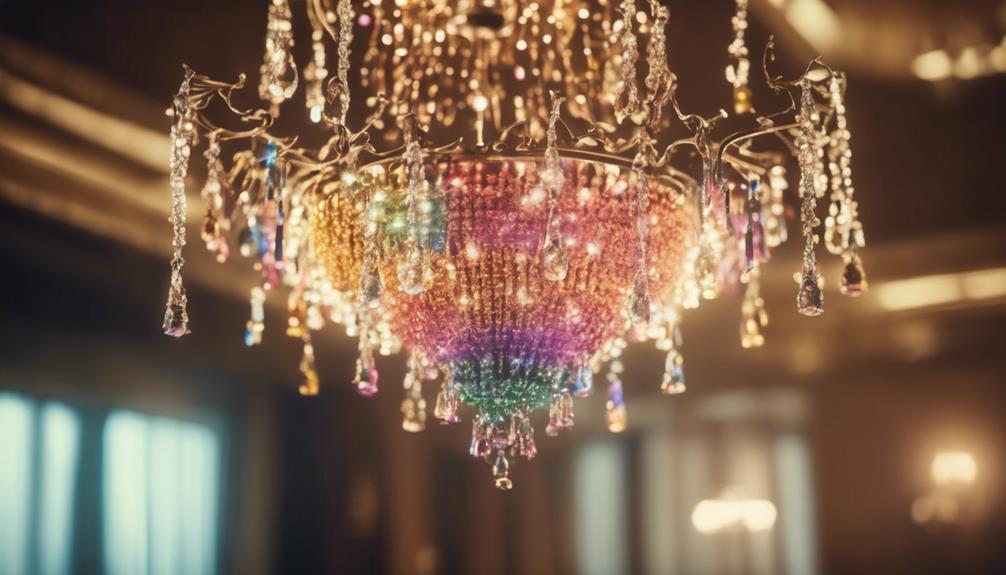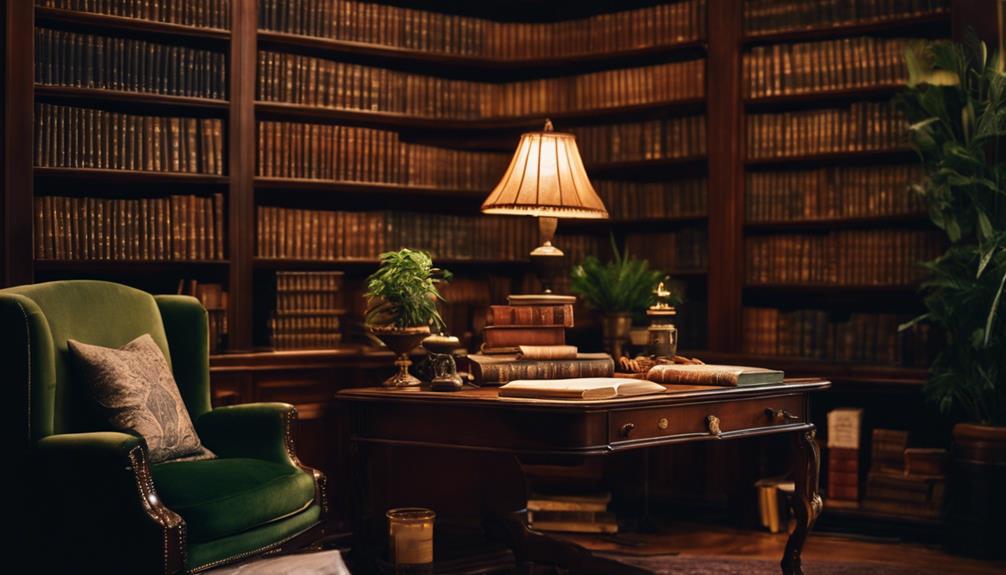You can transform your room into a dreamy oasis that captures the imagination and wows everyone who enters. Start with a pastel color palette for a whimsical vibe, or use high-contrast hues as striking focal points. Incorporate cozy textiles and natural materials, like plants, for comfort and enchantment. Essential pieces like a canopy bed with star accents or a glowing moon phase nightstand add magic. Finally, creative lighting, such as string lights or a nebula projector, will set the mood. With these elements, you're on your way to crafting a fantastical space—stick around to discover even more enchanting ideas!
Key Elements
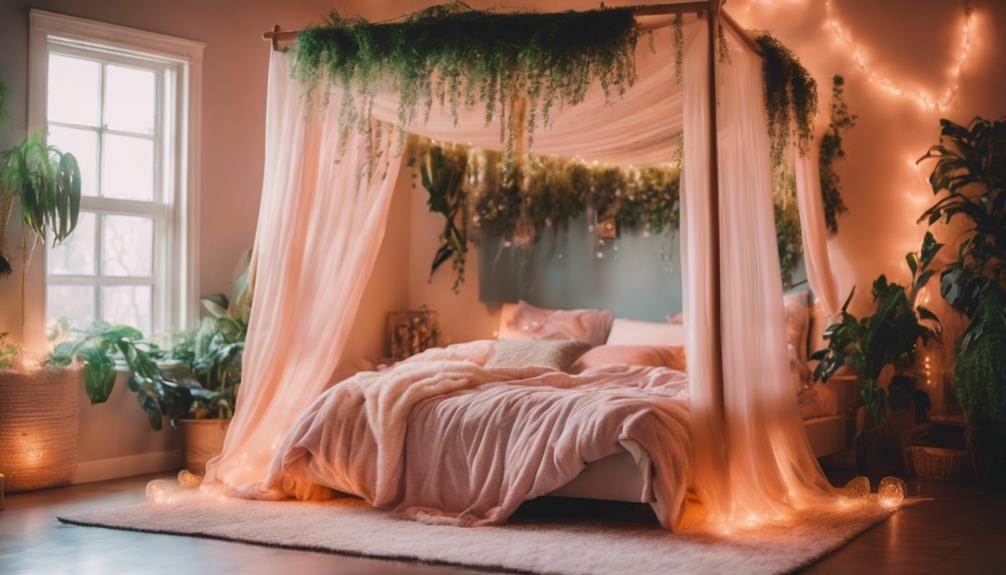
When you're planning your room decor, focusing on the color scheme, materials, and textures is essential.
These key elements set the tone and mood of your space, making it either warm and inviting or cool and modern.
Color Scheme
A well-chosen color scheme sets the tone for your room, transforming it into a serene and inviting space. To create that dreamy atmosphere, consider using a pastel palette with soft pinks, light blues, lavenders, and creamy whites. These shades work together harmoniously, fostering a whimsical vibe.
Limiting your color choices to two or three complementary hues keeps the look cohesive and visually appealing, preventing the space from feeling overwhelming.
If you want to add some drama, incorporate high-contrast colors like deep purples or navy blues against lighter tones. This approach creates striking focal points that add depth and intrigue to your decor.
Don't forget to include natural elements, such as greenery or floral patterns, within your chosen palette. They can enhance the overall aesthetic, bringing a sense of tranquility and connection to nature.
Lastly, don't shy away from introducing accent colors through accessories like cushions, rugs, or wall art. These pops of vibrancy can elevate the dreamy vibe of your space, making it feel uniquely yours.
Materials
Incorporating a variety of materials can elevate your room decor, creating a cozy and enchanting atmosphere that invites relaxation and inspiration. Start by adding soft textiles like fluffy duvet covers and ruffled cushions to bring a whimsical touch to your space. These elements not only enhance comfort but also make your room feel welcoming.
Next, utilize natural materials such as plants and floral motifs. Water lily posters and glowing succulents can create a serene vibe that complements your dreamy aesthetic. Unique lighting features, like mermaid pearl night lights and decorative lamps, serve as enchanting focal points, casting a magical glow throughout the room.
Don't forget about your walls! Use wallpaper or treatments with celestial or cloud patterns to transform them into dreamy backdrops that inspire creativity.
Finally, incorporate decorative accessories like holographic vases and crystal butterfly stickers to add personalized charm and visual interest. These materials work together harmoniously, making your space not just beautiful but also a reflection of your unique style.
Textures
Textures play an essential role in enhancing the comfort and visual appeal of your room, inviting you to explore the layers that make your space uniquely yours.
Start by mixing bedding materials; silky sheets paired with a fluffy duvet create a delightful layered effect that boosts both comfort and aesthetic.
Don't stop there—incorporate rugs, curtains, and throw pillows in diverse fabrics. This adds depth to your decor, making your room feel warm and inviting. Combining natural materials like wood with metal accents introduces a striking contrast, enriching the overall dreamy vibe.
To foster a cozy atmosphere, utilize textured items such as knitted throws or embroidered cushions. These elements beckon you to relax and unwind.
Aim for tactile variety by pairing smooth surfaces with plush textures, engaging your senses and creating a dynamic environment.
Essential Fixtures and Furniture
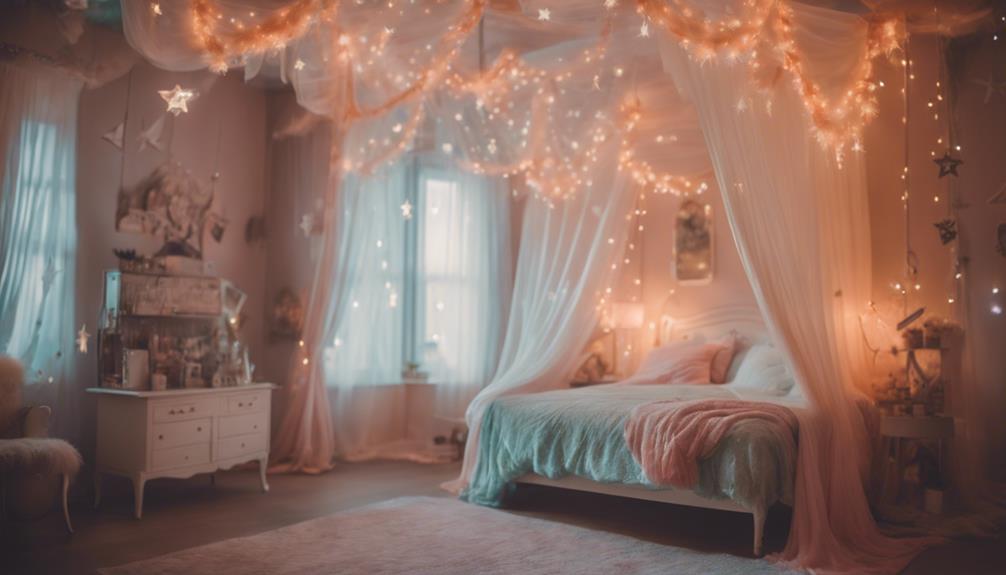
To truly transform your space, consider essential fixtures and furniture that reflect your style.
A canopy bed with star accents creates a dreamy focal point, while a glowing moon phase nightstand adds both function and whimsy.
Don't forget a celestial-themed bookshelf adorned with stars to tie everything together beautifully.
Canopy Bed With Star Accents
Enhancing a canopy bed with star accents instantly transforms your space into a dreamy oasis, perfect for stargazing from the comfort of your own room. You can start by draping string lights or star-shaped fairy lights around the canopy, creating a whimsical atmosphere that mimics a starlit sky. This enchanting glow not only adds charm but also sets a peaceful mood for relaxation.
Incorporate sheer, flowing fabrics for the canopy to achieve an ethereal quality that softens the overall look of your bed. Pair this with dark-colored bedding, which contrasts beautifully against lighter canopy fabrics, emphasizing your star accents and making your room feel more inviting.
To enhance the celestial theme, opt for bedding and cushions featuring star patterns or galaxy prints. Decorative pillows shaped like stars can further enrich the fantastical vibe while offering extra comfort.
With these elements, your canopy bed becomes not just a focal point but a cozy retreat where you can unwind and dream under your own constellation. Embrace your creativity, and let your imagination shine as you design this magical space!
Glowing Moon Phase Nightstand
Imagine having a nightstand that not only organizes your essentials but also casts a serene glow reminiscent of the moon's phases, creating a perfect ambiance for your bedroom.
The Glowing Moon Phase Nightstand is designed to add a celestial touch, making it a unique focal point in your space. With built-in LED lighting, it transforms your room into a tranquil haven at night, soothing your senses and enhancing relaxation.
This nightstand features multiple storage compartments, so you can easily keep your books, electronics, and personal items organized and within reach. Made from high-quality materials, it guarantees durability while maintaining its whimsical aesthetic, making it a smart investment for your decor.
What's great is its versatility; the Glowing Moon Phase Nightstand complements various decor styles. Whether your room leans toward dreamy or minimalist themes, this piece fits right in.
It's not just a functional fixture; it's a delightful statement that sparks joy and wonder every time you enter your room. Elevate your space with this enchanting nightstand, and let the phases of the moon guide your nightly rituals.
Celestial-Themed Bookshelf With Stars
A celestial-themed bookshelf adorned with star and moon motifs transforms your space into a dreamy haven while providing stylish storage for books and decor. To enhance the enchanting atmosphere, consider incorporating LED fairy lights along the shelves. These twinkling lights will create a starry ambiance, making your bookshelf the focal point of the room.
For added depth, opt for celestial-patterned wallpaper or paint on the back panel of the bookshelf. This design mimics the night sky, drawing the eye and enhancing the overall theme. Selecting furniture pieces with metallic finishes like gold or silver will emulate the sparkle of stars and seamlessly complement your celestial decor.
Don't forget the details! Accessories like constellation maps or star-shaped bookends can add whimsical touches and tie together the celestial theme. By thoughtfully arranging your books and decor, you'll create a visually appealing display that invites admiration from everyone who enters your room.
With a few simple additions, your celestial-themed bookshelf can become a stunning centerpiece that captures the magic of the cosmos and reflects your unique style.
Lighting Ideas
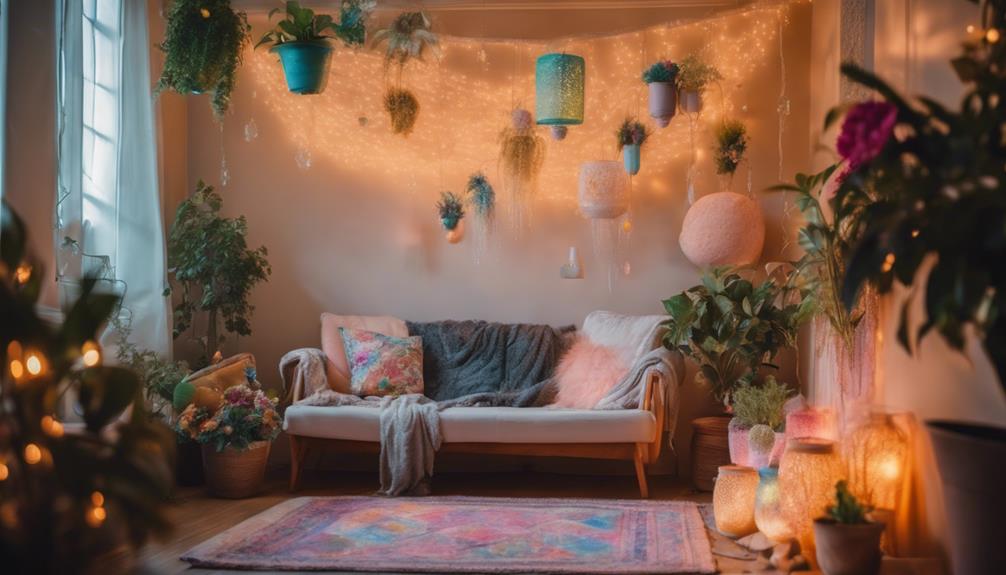
When it comes to lighting, you can transform your space with a few creative ideas.
Consider installing starry string lights for a cozy vibe, or try a luminous galaxy ceiling fixture to create a stunning focal point.
Don't forget about adding twinkling star wall sconces and a nebula projector lamp to enhance the magical atmosphere in your room.
Starry String Lights Installation
Transform your space with starry string lights, effortlessly hanging them along walls, around windows, or draping them across the ceiling for a whimsical touch. These enchanting lights can instantly elevate your room's ambiance, making it feel cozy and magical.
Opt for LED string lights; they're energy-efficient and have an impressive lifespan of up to 50,000 hours, ensuring your dreamy decor lasts long.
When installing, consider using adhesive hooks or removable mounting strips to avoid damaging your walls. This method provides a secure setup while keeping your space intact. Plus, many starry string lights feature adjustable brightness settings and various lighting modes, letting you customize the atmosphere to match different moods or occasions.
To enhance the overall aesthetic, pair your string lights with celestial-themed decor elements. This creates a cohesive look that transports you to a fantastical environment every time you enter the room.
Whether you're hosting friends or simply unwinding after a long day, the soft, twinkling glow of starry string lights will wow everyone and make your space truly inviting.
Luminous Galaxy Ceiling Fixture
Luminous galaxy ceiling fixtures can instantly turn your room into a celestial paradise, projecting stunning starry designs and vibrant nebulae onto the ceiling. These fixtures utilize LED technology, which means they're energy-efficient and offer adjustable brightness and color variations. This flexibility lets you create the perfect atmosphere, whether you want a calming night sky or a colorful cosmic display.
Many models come with remote controls or smart home compatibility, giving you easy access to customize lighting effects and set timers for automatic operation. This convenience makes it simple to achieve your desired ambiance without hassle.
To enhance the dreamy aesthetic, consider pairing your galaxy ceiling fixture with soft, pastel bedding and wall decor. This combination immerses the space in a whimsical vibe, perfect for relaxation or sparking creativity.
Incorporating a galaxy ceiling fixture into your bedroom design can transform it into a magical escape, ideal for both children and adults. You'll find that this enchanting lighting choice not only elevates your decor but also creates an inviting environment where you can unwind and let your imagination soar. Embrace the celestial charm and watch your room come alive!
Nebula Projector Lamp
The Nebula Projector Lamp takes the celestial theme further by casting stunning, colorful nebula patterns across your walls and ceiling, creating a mesmerizing atmosphere in any room.
With its adjustable brightness and color settings, you can easily customize the ambiance to suit your mood or occasion. Whether you want a calming blue hue for relaxation or vibrant colors for a lively gathering, this lamp has you covered.
Many models come equipped with built-in speakers, allowing you to enjoy soothing music or nature sounds while immersing yourself in the visual display. This adds an extra layer of tranquility to your space, making it perfect for winding down after a long day. Plus, with a convenient timer function, you can set it to turn off automatically after a set period—ideal for bedtime.
Its compact design guarantees it fits seamlessly into any room. Whether you place it on your bedside table, use it as a centerpiece in the living room, or integrate it into a dreamy bedroom setup, the Nebula Projector Lamp elevates your decor while whisking you away into a cosmic wonderland.
You'll love how it transforms your space!
Twinkling Star Wall Sconces
Twinkling star wall sconces create a magical ambiance that instantly brings the charm of a starlit sky into your home. These enchanting fixtures not only enhance the dreamy aesthetic of any room but also offer adjustable brightness settings. You can easily customize the glow to set the mood—whether you want bright and inviting or soft and serene.
Designed with energy-efficient LED bulbs, these sconces provide long-lasting illumination while keeping your energy consumption low. Plus, they come in a variety of styles and finishes, so you can effortlessly match them with your existing decor, whether it's whimsical, modern, or minimalist.
Installation is typically straightforward, making it easy for you to mount them on the wall and quickly elevate your space with mesmerizing lighting. Imagine walking into a room lit by the gentle twinkling of stars; it's a perfect way to create a soothing retreat or a whimsical haven for relaxation.
Decorative Elements
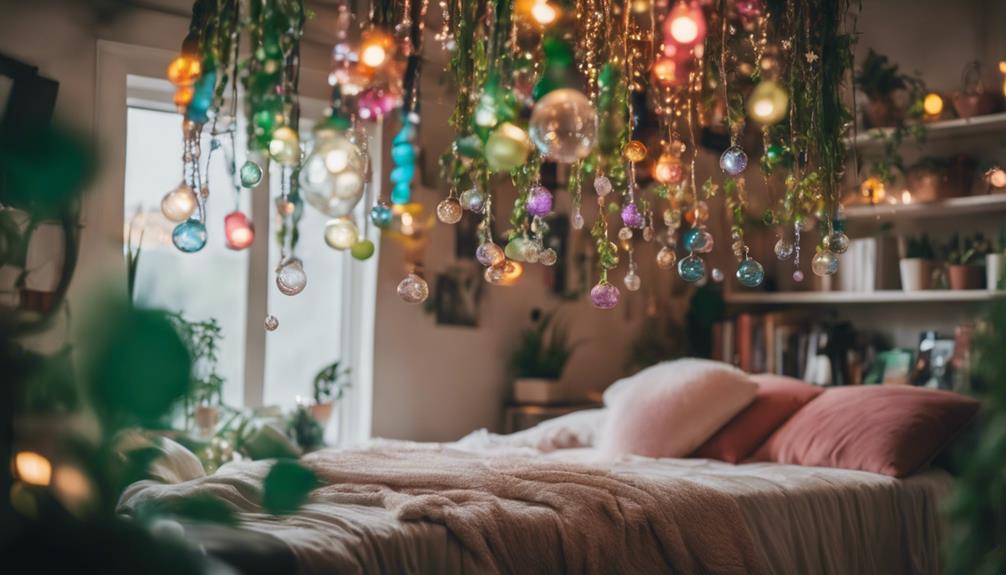
To elevate your room decor, consider incorporating celestial-themed elements that capture the beauty of the night sky.
A Celestial-Themed Wall Tapestry, paired with Starry Night Throw Pillows, can create a cozy yet enchanting vibe in your space.
Don't forget to add some Celestial Constellation Wall Art to tie everything together and inspire a dreamy atmosphere.
Celestial-Themed Wall Tapestry
A celestial-themed wall tapestry instantly transforms your space into a dreamy retreat, featuring enchanting designs of stars, moons, and galaxies that spark wonder. This striking focal point not only enhances your decor but also creates an atmosphere of serenity and inspiration. Made from high-quality textiles, these tapestries boast vibrant colors and intricate designs, adding depth and character to your room.
You'll find a variety of sizes available, so whether you're looking for a large statement piece or a smaller accent, there's a perfect fit for your wall. Hang it behind your bed for a soothing bedroom vibe or in your meditation space to foster tranquility and reflection.
To elevate the magical feel, consider pairing your tapestry with twinkling fairy lights or whimsical dream catchers, creating a cohesive and enchanting aesthetic. The celestial theme effortlessly complements other decor elements, making it easy to design a space that feels both inviting and dreamy.
With a celestial tapestry, you're not just decorating; you're crafting a fantastical environment that will wow everyone who steps into your home. Embrace the beauty of the cosmos, and let your walls tell a story of wonder and imagination.
Starry Night Throw Pillows
Starry night throw pillows add a touch of whimsy and comfort to your decor, featuring celestial motifs that enhance your room's dreamy aesthetic. Made from soft, plush fabrics like velvet or cotton, these pillows provide both comfort and style, making them perfect for lounging or adding a decorative flair to your space.
You'll find these pillows in vibrant colors like deep blues and purples, echoing the beauty of the night sky and creating a whimsical atmosphere. They serve as an eye-catching focal point in your room, drawing attention and sparking conversations among your guests.
To truly make your celestial theme shine, mix and match these pillows with other decorative items, such as cozy blankets and complementary wall art.
The versatility of starry night throw pillows means they can complement various interior styles, from bohemian to modern. Whether you place them on your sofa, bed, or an accent chair, they effortlessly elevate your decor.
With their enchanting designs and plush comfort, adding starry night throw pillows to your space transforms it into a fantastical retreat that everyone will admire.
Celestial Constellation Wall Art
Adding celestial constellation wall art enhances the whimsical atmosphere created by starry night throw pillows, bringing the beauty of the night sky to your walls. These intricate designs of stars and constellations not only add a dreamy touch but also serve as a conversation starter. You can customize many pieces in various colors and sizes, allowing you to express your style and seamlessly integrate them into your existing decor.
Consider choosing wall art with glow-in-the-dark elements to create a magical night sky effect that transforms your bedroom during the evening. This unique feature makes your space feel enchanting and cozy. Beyond aesthetics, celestial motifs spark interest in astronomy, fostering a sense of wonder about the universe.
To maximize the impact, pair your constellation wall art with other decorative elements like star projectors or LED lights. This combination creates a cohesive and immersive celestial-themed room that captivates everyone who enters.
With celestial constellation wall art, you'll not only beautify your space but also inspire a fascination for the cosmos, making your room a dreamy retreat for relaxation and imagination.
Flooring
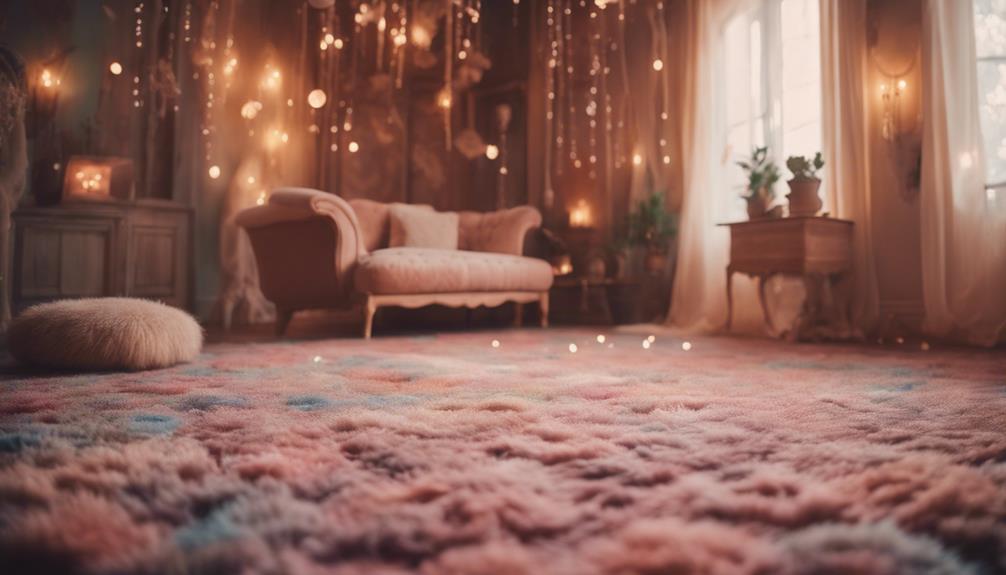
When it comes to flooring, you can truly set the tone for your dreamy space.
Galaxy-patterned carpet tiles, moonlit sky vinyl planks, and starlit sky hardwood flooring can all add a celestial touch to your room.
These options not only look stunning but also create a unique atmosphere that invites relaxation and wonder.
Galaxy-Patterned Carpet Tiles
Transform your space with galaxy-patterned carpet tiles that capture the enchanting beauty of the night sky, featuring vibrant colors and sparkling motifs. These tiles bring a touch of magic to any room, making them perfect for bedrooms, playrooms, or creative spaces. You'll love how the rich blues and purples blend to create a mesmerizing atmosphere, evoking a sense of wonder every time you walk in.
Made from durable materials, galaxy-patterned carpet tiles are designed to withstand high traffic, ensuring they remain beautiful and functional for years. Plus, their easy-to-clean nature means you won't have to worry about spills or stains ruining your dream space.
Installation is a breeze, allowing you to create custom layouts or fun patterns like checkerboards that reflect your personal style. If you're conscious about the environment, many options are available in eco-friendly materials, ensuring your decor is stylish and sustainable.
With galaxy-patterned carpet tiles, you can effortlessly enhance your dreamy room's theme and create a fantastical space that will wow everyone who enters. So go ahead, let your imagination soar and transform your flooring into a celestial wonderland!
Moonlit Sky Vinyl Planks
Moonlit Sky Vinyl Planks create a serene ambiance that beautifully mimics the enchanting allure of a nighttime sky, perfect for enhancing your dream room. These stunning planks offer a unique design that serves as a mesmerizing backdrop, allowing your space to feel both magical and inviting.
Crafted from durable, water-resistant materials, Moonlit Sky Vinyl Planks are ideal for bedrooms and living areas alike. You won't have to sacrifice style for functionality, as these planks stand up to everyday wear while maintaining their visual appeal.
Installation is a breeze, making it easy for you to transform your space quickly, whether you're a DIY enthusiast or working with a professional. The soft texture underfoot adds comfort and warmth, enhancing the cozy atmosphere that's essential for a fantastical environment.
With various sizes and styles available, these vinyl planks can effortlessly integrate into any design theme, from minimalist to whimsical. So, if you're looking to elevate your room decor, consider Moonlit Sky Vinyl Planks for a perfect blend of beauty and practicality in your dreamy space.
Starlit Sky Hardwood Flooring
For those seeking a whimsical touch to complement the serene ambiance of Moonlit Sky Vinyl Planks, Starlit Sky Hardwood Flooring offers a stunning design that captures the enchanting patterns of a night sky. This unique flooring creates a dreamy atmosphere, making it perfect for any room in your home.
Crafted from high-quality, sustainable materials, Starlit Sky Hardwood Flooring not only enhances your space's aesthetic appeal but also guarantees durability and longevity. You can choose from various finishes to perfectly match your interior style, whether you prefer contemporary elegance or rustic charm.
Its smooth surface makes cleaning and maintenance a breeze, allowing you to keep your fantastical decor looking pristine with minimal effort. To create a cohesive atmosphere, pair the flooring with soft lighting and celestial-themed decor, such as starry wall art or twinkling fairy lights.
Conclusion
By incorporating these dreamy decor elements, you can transform your space into a fantastical retreat that'll leave everyone in awe.
Remember to choose essential fixtures and furniture that resonate with your vision, play with lighting to create the perfect ambiance, and add whimsical decorative touches to elevate the atmosphere.
With the right flooring to tie it all together, you'll have a magical room that reflects your personality and invites creativity.
So, let your imagination run wild!
